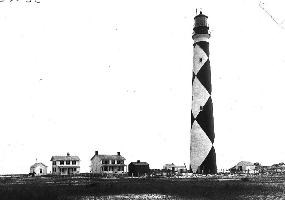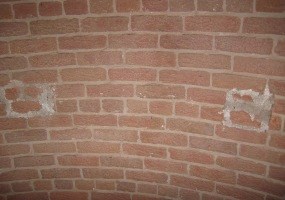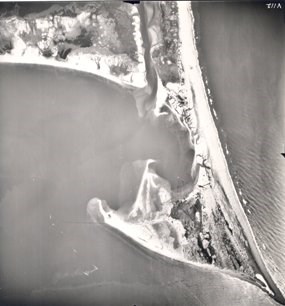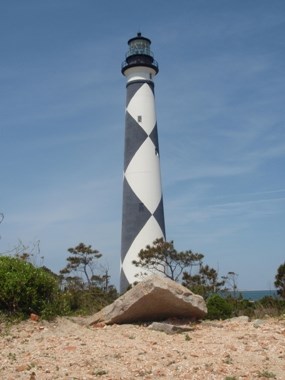
1804The United States Congress authorizes the construction of a lighthouse "… on or near the pitch of Cape Lookout." 1812The first Cape Lookout Lighthouse is completed at a cost of $20,678.54. It is a wood frame octagonal tower with a brick stairwell. The boarded exterior is shingled and painted with red and white horizontal stripes. Its mechanism consists of thirteen lamps with 21-inch parabolic reflectors. The focal plane of the light is 96 feet above ground and 104 feet above sea level. President James Madison appoints James Fulford as the first keeper at a salary of $300 a year. 1851Complaints from seafarers are making it evident that a taller and more stable lighthouse is needed. Though attempts are made to renovate the first Cape Lookout Lighthouse, eventually the decision would be made to replace the outmoded structure. 1852The U.S. Lighthouse Board is created and assumes control of all aids to navigation. 1856Over the years, the effectiveness of the lamp and parabolic reflector system is questioned. The Lighthouse Board finally gets around to ordering a first-order Fresnel lens in the lighthouse. The Board also takes action to have the tower rebuilt. However, evidence suggests that the old lighting system continues to be in use until the completion of the new tower. 1857Congress appropriates $45,000 to build a new lighthouse at Cape Lookout. 
November 1, 1859The new Cape Lookout Lighthouse is completed and lighted. It is a red brick tower, 163 ft high; a spiral iron staircase winds to the top. The first-order Fresnel lens displays a fixed light that can be seen 18 miles in good weather. This tower is the first of this new style to be built along the Outer Banks. The old 1812 tower is converted to a keeper's quarters (the old lighting apparatus is removed from the lantern) and is shown on charts as late as 1868. May 20, 1861North Carolina joins the Confederacy. The lenses from all coastal lighthouses and navigational beacons are ordered removed from their working locations and stored until after the war by the new Confederate government. 1862Union troops capture Beaufort and Morehead City and, after a short battle, the Confederate troops defending Fort Macon surrender. 1863A third-order Fresnel lens is installed in the lighthouse by the Union. Although the range is reduced, the Cape Lookout lighthouse once again warns ships of the nearby shoals. Whale oil, which is used as fuel for the light, climbs to $2.43 per gallon and the Lighthouse Board searches for a cheaper substitute fuel. 
April 2, 1864A small group of Confederate troops under the command of L.C. Harland sneak through Union lines and out to the lighthouse. Their attempt to blow up the lighthouse is unsuccessful, however the explosion does destroy the lighthouse oil supply and damages the iron stairs. With iron unavailable during the war, the damaged sections of the stairs are replaced by wooden ones. 1865The Fresnel lenses from all the North Carolina lighthouses are found in Raleigh, NC The lenses are shipped back to their original manufacturers to be checked out and repaired. 1867The temporary wooden stairs are replaced when iron once again becomes available after the war. The original first-order Fresnel lens is reinstalled. Congress sets the average rate of pay for the Keeper at $600 a year (about $9,700 in 2012 dollars). This wage does not change for the next 50 years. 1873The new keeper's quarters is completed. It eventually housed two assistant keepers and their families. (This is the present Keeper's Quarters Museum.) The lighthouse is painted with its distinctive diagonal black-and-white checkers to distinguish it as a day marker. Mineral oil (kerosene) becomes the fuel used to ignite the lamp. 1892Lack of confidence in shorebased lighthouses raises the recommendation for a lightship at the southern extremity of Cape Lookout Shoals. This would protect the mariner in hazy weather when a vessel might be on the shoals before seeing the Cape Lookout Lighthouse. Congress takes no action at this time. 
1904A lightship is anchored on the shoals. The steam fog signal warns mariners away from the dangerous waters. Through the years, a lightship remains on station despite being torn from its moorings during storms. 1910The Lighthouse Board is dissolved, and replaced by the Bureau of Lighthouses. 1914The lower gallery is widened to accommodate a storm entry over the external hatchway. The light source is changed from a wick lamp to a 75-millimeter incandescent oil vapor lamp (IOV). The change increases the light's brightness from 9,000 to 77,000 candlepower. An occulting device is also installed changing the light characteristic from a fixed white light to a "flashing" light. The light now shows "31" (three 9 second flashes of light, then one 9 second flash of light) twice every ninety seconds. August 15, 1933The installation of a radiobeacon and electric lighting equipment is completed. The 75-millimeter incandescent oil vapor lamp is replaced with four 250-watt T-14 electric lamps (bulbs), this change increases the candlepower from 77,000 to 160,000. Generators supply the electricity for the new equipment. 1933This is the last year a lightship is stationed off the Cape Lookout Shoals until WWII. 
September 1933A hurricane striking the area opens the inlet between Core Banks and Shackleford Banks. 1939The Bureau of the Lighthouses is incorporated into the U.S. Coast Guard. 1950The Cape Lookout Lighthouse becomes automated--making it able to turn the light on and off as needed. Electrical power is still provided by diesel powered generators, requiring someone to maintain and repair the generators. With the departure of the resident lightkeepers, the nearby Cape Lookout Coast Guard Station adds monitoring the lighthouse to its duties. The radiobeacon is moved from the lighthouse grounds to the Coast Guard station. September 1975The Fresnel lens is removed and replaced with two DCB-24 aerobeacons. These turn at the speed of one full revolution every 30 seconds. With the lights mounted back to back, the new light pattern is one “flash” every 15 seconds. The Fresnel lens is shipped to its new home – the Portsmouth Coast Guard Support Center in Virginia and placed on display. May 18, 1982The nearby Cape Lookout Coast Guard Station was closed and its rescue duties were taken over by Ft. Macon Station. Upon the station’s closure, it was immediately reopened as the Cape Lookout Light Station. This was to allow for the operation of the light until an underwater electrical cable could be laid from Harkers Island. Once this was accomplished the lighthouse would be completely automated. 
July 14, 2003The lighthouse tower and remaining lighthouse property is transferred from the U.S. Coast Guard to the National Park Service in a public ceremony. An "Open House" is held allowing members of the public to climb the historic tower. These "Open House" events are held on two additional days in 2003 and four days per year from 2004 to 2007. January 2008Following an inspection of the structure, the lighthouse tower is closed to climbers and the "Open House" days scheduled for 2008 are canceled for visitor safety. July 15, 2010With the repairs completed and the inspection passed, the lighthouse opened to the public for regular climbs for the first time in its history. |
Last updated: October 20, 2023
